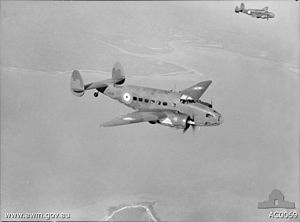- No. 13 Squadron RAAF
-
13 Squadron 
Two Hudson aircraft from No. 13 Squadron near Darwin in 1940Active 1 June 1940 – 11 January 1946
1 July 1989 – currentBranch RAAF Role Base operations and training Part of Combat Support Group Garrison/HQ RAAF Base Darwin Motto "Resilient and Ready" Commanders Notable
commandersJohn Balmer (1940–41) No. 13 (City of Darwin) Squadron is a Royal Australian Air Force squadron. The Squadron saw combat during World War II as a bomber and maritime patrol squadron and is currently active as a mixed regular and reserve RAAF unit located in Darwin, fulfilling both operational support and training duties.[1]
Contents
History
No. 13 Squadron was formed from elements of No. 12 Squadron at RAAF Base Darwin on 1 June 1940. The Squadron initially served in the general reconnaissance role and flew maritime surveillance patrols over the seas to the north of Australia and survey flights over northern Australia. In May the Squadron began flying familiarisation flights over the Netherlands East Indies in preparation to deploy to the NEI following the outbreak of war with Japan.
Following the start of the Pacific War, No. 13 Squadron deployed two flights of Hudson light bombers to Ambon. Flying in the face of heavy resistance these aircraft conducted patrols throughout the eastern islands of the NEI, locating a number of Japanese convoys. The surviving aircraft from these flights returned to Darwin in February 1942, as Ambon faced invasion. However, the squadron commander, Wing Commander Ernest Scott, was killed in a massacre by Japanese troops following the battle.
No. 13 Squadron was severely affected by the Japanese Air raids on Darwin on 19 February 1942, with the Squadron's headquarters, stores and spares being destroyed. As a result of the Squadron's heavy losses during the defence of the NEI and the raids on Darwin, No. 13 Squadron generally only had one or two aircraft operational on most days in early 1942. Nevertheless, the Squadron continued to fly operational attack and reconnaissance missions over the NEI. No. 13 Squadron was later awarded the United States Presidential Unit Citation for its operations over Timor during August and September 1942. No. 13 is one of only two RAAF Squadrons to have received this honour (the other unit being No. 2 Squadron which received the award for its performance in the Vietnam War).
The Squadron continued to conduct operations against the Japanese until 4 April 1943 when it handed its Hudson aircraft over to No. 2 Squadron and was withdrawn to RAAF Base Fairbairn to rest and re-equip. At Fairbairn the Squadron took delivery of Bristol Beaufort and Lockheed Ventura aircraft and conducted anti-submarine and shipping patrols along the Australian East Coast. The Beauforts were handed over to No. 2 Squadron in August. The future Australian Prime Minister Gough Whitlam joined the Squadron as a navigator during 1943.
No. 13 Squadron moved to Cooktown in late May 1944 before moving again to Gove in August. From Gove the Squadron mainly carried out anti-submarine and escort patrols, though it appears to have also mounted a small number of bombing raids against the eastern islands of the NEI.
In late June 1945 the Squadron moved to Morotai in the NEI and, soon after the end of the War, to Labuan in British North Borneo. From Labuan the Squadron operated in the transport role and ferried ex-Prisoners of War and other personnel back to Australia before being disbanded on 11 January 1946.
No. 13 Squadron was re-formed as a non-flying Air Force Reserve Squadron located at RAAF Base Darwin on 1 July 1989. On 31 May 1990 the Squadron was officially presented the Presidential Unit Citation it had been awarded in 1942.
On 1 July 2010 changes to the structure of the Combat Support Group resulted in the combat support and fixed base services functions of No. 321 Expeditionary Combat Support Squadron (321ECSS) being integrated with No. 13 Squadron at RAAF Darwin and 321ECSS being disbanded.[2]
Aircraft operated
- Avro Anson (June 1940)
- Lockheed Hudson (June 1940 – April 1943)
- Bristol Beaufort (April–August 1943)
- Lockheed Ventura (April 1943 – January 1946)
Notable former members
- Gough Whitlam - Prime Minister of Australia (1972-1975)
References
- ^ Stackpool, Andrew (5 August 2010). "Over To You Now". Air Force: p. 6. http://digital.realviewtechnologies.com/default.aspx?iid=38875&startpage=page0000006. Retrieved 25 September 2011.
- ^ Stackpool, Andrew (5 August 2010). "Over To You Now". Air Force: p. 6. http://digital.realviewtechnologies.com/default.aspx?iid=38875&startpage=page0000006. Retrieved 25 September 2011.
- RAAF Museum 13 Squadron
- RAAF No. 13 Squadron Official Website
- Steve Either (1995) Flying Squadrons of the Australian Defence Force. Aerospace Publications.
- RAAF Historical Section (1995), Units of the Royal Australian Air Force. A Concise History. Australian Government Publishing Service, Canberra.
Main series 1 · 2 · 3 · 4 · 5 · 6 · 7 · 8 · 9 · 10 · 11 · 12 · 13 · 14 · 15 · 20 · 21 · 22 · 23 · 24 · 25 · 26 · 27 · 28 · 29 · 30 · 31 · 32 · 33 · 34 · 35 · 36 · 37 · 38 · 40 · 41 · 42 · 43 · 60 · 66 · 67 · 71 · 73 · 75 · 76 · 77 · 78 · 79 · 80 · 82 · 83 · 84 · 85 · 86 · 87 · 92 · 93 · 94 · 99 · 100 · 102 · 107 · 292 · Fighter · Rescue and Communication · Seaplane · Berlin Air Lift
Article XV squadrons Joint Netherlands-Australian squadrons Categories:- RAAF squadrons
- Military units and formations established in 1940
Wikimedia Foundation. 2010.
